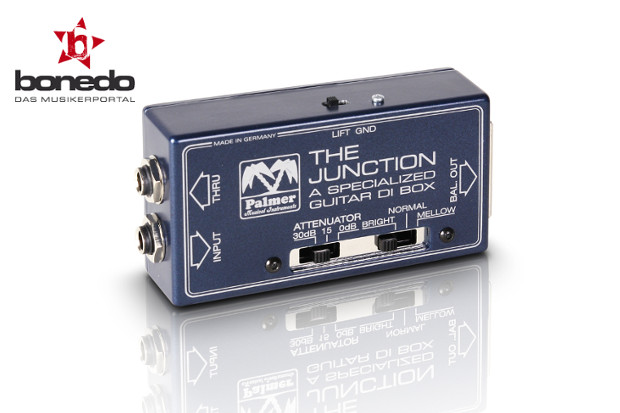Palmer PDI-09 The Junction – Pocket-sized speaker simulator – Test report by Bonedo.de
Anyone looking at speaker simulation ought to know that it is a topic of never-ending debate. The various factors involved with miking up guitar loudspeakers are not only plentiful but also very different. For example, the end result depends greatly upon the type of speaker used. Even with that, there are a dazzling array of options. One persons swears by traditional Greenbacks, someone else will only use Hanf speakers or old Blue Bulldogs, who always go for Vox AC 30 which are for many the last word in speakers. The next part in the chain is the microphone. Should it be an SM 57 or an MD 421, or even a Royer ribbon microphone? And we mustn’t forget the question of how far in front of the favorite loudspeaker the microphone should be placed, and in which position.

With “The Junction”, Palmer presents a small DI box that additionally offers speaker simulation. Passive filter circuits “bend” the frequency response of the final-phase signal pretty much in the way a guitar loudspeaker does. We also need to know that these differ hugely from hi-fi loudspeakers. They only return a small part of the frequency spectrum and thus play a key role in how the sound is formed. Transferring mids in particular works well from guitar loudspeakers, but frequencies below 60 Hertz and above 4 kHz are greatly curtailed. This is the only way of making distorted sounds at all bearable because if you connect a distorting Marshall amp to a full-range speaker the sound more closely resembles the screaming noise made by a circular saw than the riffs in “Still Got the Blues“.
Set
The Palmer DI box features three connectors, two of which are jack sockets. Since this device is positioned between the amp and loudspeaker, one side has the guitar loudspeaker connected while the other side is hooked up to the guitar amp’s speaker output, with the power amp signal looped through. The PDI-09 comes without an integrated dummy load and as a result cannot perform the role of a power soak. So a guitar speaker must always be connected to it otherwise the power amp would very rapidly bow out of proceedings for good.

The rectified frequency signal is on the XLR socket opposite and can be immediately sent on to the mixer console. The sound can be modified via three switch-controlled options. The settings available are Bright, Normal and Mellow; the signal is therefore more or less curtailed in the upper frequency range. A second switch labeled “Attenuator” adjusts the output level and offers three settings: 0 dB, -15 dB and – 30 dB. A ground lift switch helps eliminate hum if adjustment problems occur between the guitar amp and the mixer.

In practice
The Palmer speaker simulator provides invaluable help in live-performance situations, particularly at smaller gigs or for working with teams of inexperienced technicians. Of course, the device can’t be a truly viable alternative to miking up a guitar speaker, as its sound is simply too limited and static. No manufacturer has ever actually succeeded in imitating a vibrating membrane 100% so far and with the PDI-09 Palmer did not aim to design a device that does it all. You either like the sound, or you don’t. When I tested all the sounds, the setting I liked best of all was “Normal”. For me, there was something missing in the other two settings – the sound was either too harsh or too muffled for my liking.
Special attention should be given to the range around about 1 kHz because this was where my capabilities really got tested quite quickly. For an experienced sound technician it would pose no problems as long as they were familiar with using the equalizer on a mixer. For me, the most interesting use of this little gadget would be when working it with a miked-up guitar speaker: a well-versed technician could mix a fatter sound here or distribute the signals differently. A connected loudspeaker or separate dummy load are a must though when using the PDI-09.
Audio samples are here for you to listen to: http://www.bonedo.de/artikel/einzelansicht/palmer-pdi-09-the-junction/3.html
Summary
Anyone looking for an easy-to-use speaker simulator that is also suitable for smaller gigs need look no further than “The Junction” made by Palmer. It’s easy to operate and the sound it produces measures up to that of other products. For studio use though I would definitely go for the classic approach of miking up a guitar speaker.
For
+ Compact
+ Easy to use
+ Value for money
Against
– The sound for both outer switch positions drops off compared to the center one
Technical data
Connections: In/Out, Bal. out (XLR)
Switch: Bright/Normal/Mellow, Attenuator: 0 dB, -15 dB, -30 dB, Ground lift
_______________________________________
Source: Bonedo.de: http://www.bonedo.de/artikel/einzelansicht/palmer-pdi-09-the-junction.html
Author: Robby Mildenberger
You can find all the information about the Palmer PDI09 here:
http://www.palmer-germany.com/mi/en/PDI-09-Passive-DI-Box-for-Guitars-PDI09.htm
Leave a Comment
You must be logged in to post a comment.











